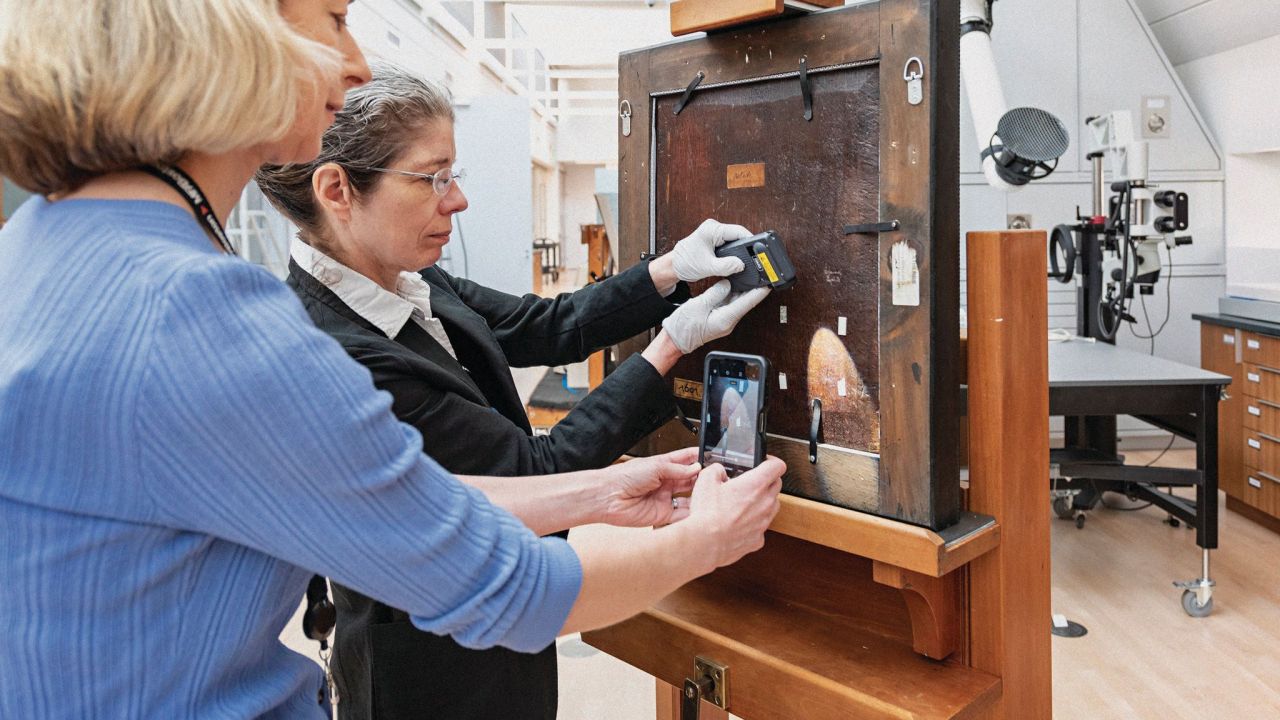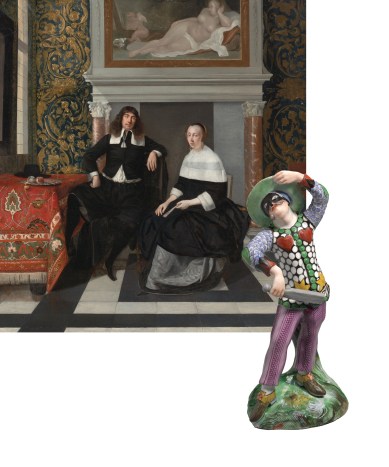
Museums need to go beyond the letter of the law and uphold a high ethical standard in building and maintaining our collections.
This article originally appeared in Museum magazine’s November/December 2023 issue, a benefit of AAM membership.
It seems like art restitution is in the news now more than ever. Every day, stories emerge about museums removing works of art from their collections and returning them to previous owners or source communities. But Nazi plunder is not the same as archaeological looting, neither of which is comparable to conversations happening around colonialism or the Parthenon Marbles.
Seeing art restitution as a monolithic category—as press accounts often do—inevitably blurs lines between very different issues. Not all museum returns are the same, but what are the differences, and what do they have in common?
In thinking about why museums restitute art in the first place, we need to consider what a museum is. We are institutions that collect and preserve works of art, of course, but we are more than that. We are, largely, educational and nonprofit; we are supported by the generosity of our donors; and, most important, we serve the public. In fact, you often hear that we hold our collections in the public trust. Taking a broad view, we restitute because displaying stolen art is not in the interest of the public trust.
At the Museum of Fine Arts, Boston (MFA), our collections policy—the document that dictates how we handle all collection-related matters—states that we will not collect anything known to have been stolen or illegally appropriated unless the object was subsequently returned, or the theft has otherwise been redressed. That sounds obvious. A basic tenet of American law is that a thief cannot convey good title and, like everyone else, museums must obey the law.
To date, the return of illicit artifacts from American museums has been rooted in legal precedent rather than purely ethical principles. For example, art looted during World War II was never legal to buy and sell in the US, and the legislation in many archaeologically rich countries has determined whether objects from their soil may be legally exported and sold here. When we return Nazi-plundered art or recently looted antiquities, we acknowledge those legal frameworks.
But the law is the minimum standard to which we must adhere. As public, educational institutions, it is reasonable to expect museums to go beyond the letter of the law and uphold a high ethical standard in building and maintaining our collections. Unlike the law, however, which is relatively fixed, ethical considerations on collecting are constantly evolving.
Five Theft Categories
In this landscape, how do we define “stolen”—in other words, how do we identify an object in our collection that is suitable for restitution? This is where provenance becomes important. We must look at the history of possession and movement of an object from the time of its creation to the present and construct a life history for it. Then we look for breaks in that chain of ownership, which can indicate thefts, forcible sales, and other transfers without the knowing consent of the owner.

Portrait of a Man and Woman in a Refined Interior is part of the Seth K. Sweetser Fund and Figure of Harlequin is part of the Kiyi and Edward M. Pflueger Collection—bequest of Edward M. Pflueger and gift of Kiyi Powers flueger, from the estate of Emma Lazarus Budge; photos © Museum of Fine Arts, Boston
The problem, however, is that thieves rarely leave a paper trail. When faced with a restitution claim, museums should not necessarily expect a “smoking gun” showing precisely when and how a work of art was taken in order to assess the claim fairly. Not every question may be answerable. Decisions about restitution must be based on a solid foundation of research, but they also call for small leaps of faith. We must be comfortable taking those leaps if we are to act ethically rather than strictly legally.
Over the past 25 years, the MFA has deaccessioned and returned, or otherwise reached financial settlements to retain, works of art that were lost to previous owners in several different ways. What these objects have in common is that they can be broadly defined as stolen. There are differences, however, and the losses can be grouped into five general categories.
The first can be called garden-variety theft. Works of art stolen from private homes or other cultural institutions obviously cannot stay in our collection. Unfortunately, not every theft is reported to law enforcement or documented reliably. In returning stolen objects, we have had to consider the probability of a theft under the given circumstances. Sometimes there is an indication that the owner (e.g., a university collection) accounted for a work of art at a particular date, but after a certain point it could not be located—with no plausible explanation for its disappearance other than a theft.
Archaeological looting—the illicit excavation of antiquities from burial sites—is a second category. Many countries have passed laws that vest the ownership of their archaeological heritage with the government, and in recognition of these laws, the MFA has in recent years returned antiquities to Italy, Turkey, Nigeria, and Mali.
What makes archaeological looting tricky to determine, however, is that nobody knows what is in the ground before it is dug up, so there is no way to report what has gone missing. When faced with a claim for archaeological materials, museums have to look at the likelihood that an antiquity was looted during a particular timespan. Was it deliberately mis-declared at an international border? Is its ownership history fanciful, perhaps too good to be true, and still not verifiable? Is it stylistically consistent with other objects known to come from a looted site? These red flags still may not constitute enough circumstantial evidence to make a determination about ownership, but they should be taken into consideration.
A third category is wartime pillage. The Hague Convention of 1907 sought to protect artwork and prohibit pillage during war, and its provisions were greatly expanded over the course of the 20th century. The MFA has returned works of art taken during World War I and World War II. But how far back are we willing to go?
Many museums are starting to consider the return of artwork taken in conflicts that pre-date the 20th century, like the so-called Benin Bronzes, which were plundered by English soldiers in what is now Nigeria in 1897. If we return 19th century war loot, we might ask, aren’t we just applying today’s standards to events of the past? Not necessarily. France repatriated looted artwork after the Napoleonic Wars (1815), setting a new standard for European nations in conflict.
However, the norms were upheld unevenly, and usually along cultural and racial lines. From the battlegrounds of Asia and Africa, European soldiers continued to bring home textiles, luxury goods, and other works of art. It is thus not unreasonable for museums today to seek to correct that imbalance by resolving claims for 19th century war loot.
State expropriation, or the taking of private property by a government, is a fourth category, the most familiar example of which is Nazi-looted art. Many museums have works of art that were stolen from Jewish collectors and nationalized by National Socialist Germany, only to be recovered and restituted by Allied forces after the end of World War II. Because of the copious documentation that survives, these cases tend to be relatively easy to identify and straightforward to research.
The fifth and most expansive category is that of sales under duress or other forcible transfers. Forced sales happened frequently under the Nazi regime. Jewish collectors often had to sell their art to pay discriminatory fines and taxes or to finance their flight to safety. Even absent the direct involvement of the Nazis, many collectors had to abandon or sell their belongings when they had no other means of subsistence. Sometimes they received proceeds, other times they received a fraction of what they were owed, or could only access funds through tightly controlled bank accounts.
Duress transactions are not limited to the Holocaust. Brutal periods of colonization—particularly in Africa and Asia—led to communities being stripped of their tangible heritage throughout the 19th and 20th centuries. Indigenous burial goods, sacred objects, and other items of cultural patrimony were forcibly removed from tribal land as the result of settler colonialism in North America. NAGPRA (Native American Graves Protection and Repatriation Act) provides a framework for repatriation claims for American museums, although it does not extend to claims from Indigenous peoples outside the United States.
It is this final category that most urgently calls upon museums to act ethically, rather than strictly legally, in assessing ownership claims. We must look beyond the provenance of the work of art to consider the full set of circumstances in which it changed hands. And even after exhaustive research, questions are likely to remain. The MFA has reached a number of settlements for works of art that were lost or forcibly sold during the Holocaust. In those cases, when faced with an incomplete paper trail and lingering questions, we had to consider the probability of coercion given the historical context. How likely was it that money was received? How much agency would an owner have had in parting with this property at the time?
Consistency Is Key
Whatever the type of claim, when coming to a decision about ownership, museums must be consistent in their reasoning. We must determine whether it’s reasonable to conclude, given the available information, that the object has been taken, lost, or involuntarily given and not subsequently returned. If the answer is no, then it is not an appropriate candidate for restitution, and we should share our research and thought process with the claimants. If the answer is yes, then we must be prepared to acknowledge that the object does not rightfully belong to us and seek a resolution with the rightful owners.
Resolving ownership disputes does not always have to entail a physical return. A full or partial financial settlement, long-term loan, or shared stewardship agreement are just a few ways to acknowledge and repair broken chains of ownership. The important thing is that the loss is redressed in some way, and the resolution is the result of an open dialogue between the museum and the claimant.
Being willing to enter into these conversations and being fully transparent about our actions are undoubtedly the best ways for museums to be accountable to our many audiences—and uphold the public trust—in the 21st century.
When Not to Restitute
When it comes to decisions about restitution, ownership is generally determined by several factors: Is the claimed object identical to the museum’s object? Is the museum communicating with all the rightful claimants? And does the history of possession and movement indicate theft or involuntary transfer?
Conversely, museums are wise not to make restitution decisions based on the following factors:
- an object’s financial value (“This is so valuable, we must deny the claim.”)
- its importance to the collection (“We’re never going to show it, so let’s give it back.”)
- its desirability to others (“It was legally sold but would take pride of place in this small town.”)
- a subjective opinion about the claimant (“They won’t value it like we do.”)
Every decision sets an internal precedent. If we rely on such criteria in one instance, nothing is to stop us from relying upon them again in the future—at which point we risk breaking up our collections subjectively and haphazardly.
Resources
Museum of Fine Arts, Boston Acquisitions and Provenance Policy
mfa.org/collections/provenance/acquisitions-and-provenance-policy







